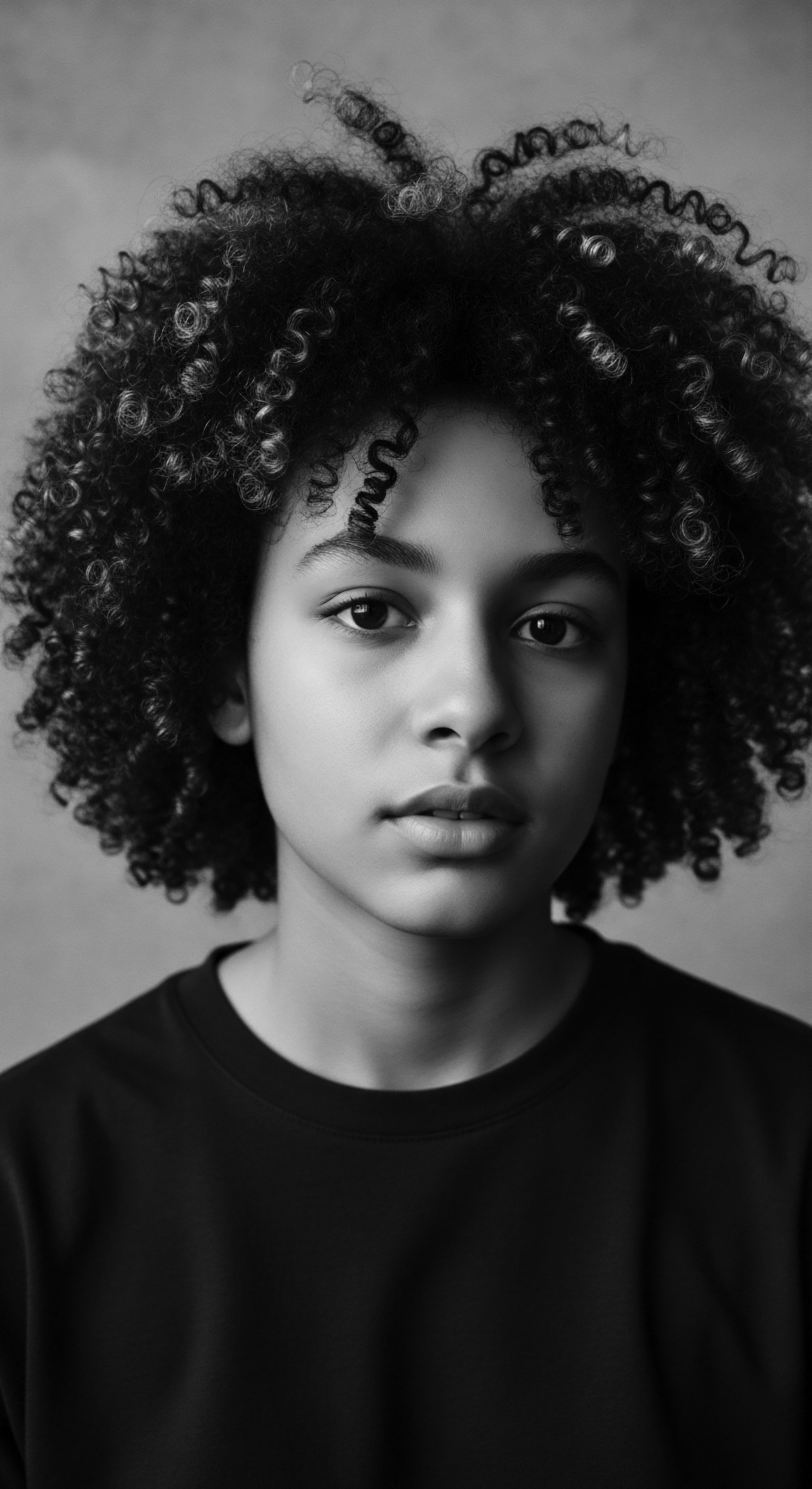
Fundamentals
The concept of ‘Plant Uses’ within the vibrant world of Roothea refers to the intentional application and profound significance of botanical elements in the holistic care and cultural expression of textured hair. This encompasses the myriad ways in which leaves, roots, barks, seeds, flowers, oils, and extracts from the plant kingdom have been, and continue to be, utilized to nourish, protect, adorn, and celebrate coils, curls, and waves across diverse heritage lines. It is a fundamental understanding that these plant-derived ingredients are not merely cosmetic additives; rather, they are conduits of ancestral wisdom, embodying generations of knowledge passed down through oral traditions and lived experiences.
From the earliest communal gatherings where elders shared secrets of the earth’s bounty for scalp health and hair resilience, the application of plants has been interwoven with daily life and significant rites of passage. These natural resources offered practical solutions for cleansing, conditioning, and styling hair, especially in environments where commercial products were nonexistent or culturally inappropriate. The very meaning of ‘Plant Uses’ extends beyond simple utility; it signifies a deep, reciprocal relationship between humanity and the natural world, particularly for communities whose hair has often been misunderstood or marginalized in dominant beauty narratives.
Understanding the elemental biology of these plant applications means recognizing their inherent properties. For instance, the saponins present in certain plant parts, like those found in Shikakai or Reetha, provide a gentle cleansing action, removing impurities without stripping natural oils, a crucial aspect for maintaining the delicate moisture balance of textured hair. Similarly, the rich fatty acids within plant butters and oils offer profound emollient benefits, sealing moisture into hair strands.
The use of plants for textured hair care represents a timeless dialogue between ancestral wisdom and the living vitality of the earth.
The initial engagement with Plant Uses often begins with familiar, deeply revered ingredients. These botanical allies have earned their place in the heart of textured hair care through centuries of proven efficacy and cultural resonance.
- Shea Butter ❉ Known locally as ‘nkuto’ in Ghana, this creamy substance from the Vitellaria paradoxa tree has been a cornerstone of West African hair and skin care for millennia. Its moisturizing and protective qualities are unparalleled for coils and curls.
- Coconut Oil ❉ A versatile oil, widely used across the diaspora, it penetrates the hair shaft, reducing protein loss and adding shine, making it a staple for nourishing Afro-textured hair.
- Aloe Vera ❉ Celebrated for its soothing and hydrating properties, this succulent plant provides relief for the scalp and conditions hair strands, a common ingredient in traditional remedies.
- Castor Oil ❉ Particularly popular for promoting hair growth and scalp health, especially in Caribbean and African American communities, its thick consistency helps seal in moisture.
These fundamental applications of plant wisdom underscore a simple yet profound truth ❉ nature holds powerful solutions for hair care, solutions that have sustained and adorned generations. The initial exploration of Plant Uses reveals a foundational respect for natural ingredients, a reverence that forms the bedrock of Roothea’s perspective on textured hair heritage.

Intermediate
Expanding upon the foundational understanding, the intermediate meaning of ‘Plant Uses’ delves into the historical evolution and communal integration of these botanical practices. It signifies a deeper appreciation for how plant-based hair care traditions have traversed continents and generations, adapting while retaining their intrinsic cultural value. This segment illuminates the intentionality behind the selection and preparation of specific plants, recognizing them not just as raw materials, but as components of intricate rituals that fortified both hair and spirit.
The historical trajectory of Plant Uses is particularly compelling within the context of textured hair heritage. Prior to the widespread advent of commercial products, and certainly before the pressures of Eurocentric beauty standards took hold, communities across Africa and the diaspora relied exclusively on their botanical surroundings. These practices were not merely about hygiene or aesthetics; they were integral to social cohesion, identity markers, and even forms of silent communication.
For instance, during the transatlantic slave trade, enslaved Africans braided rice seeds into their hair as a means of survival and to preserve the culture of their homeland, utilizing hair as a vessel for hidden messages and a tool for resistance. This powerful historical example showcases the profound significance of hair, and by extension, the plants used to care for it, as a site of enduring heritage and resilience.
The journey of plant-based hair care across the diaspora mirrors the resilience of communities preserving their heritage through generations.
The understanding of Plant Uses at this level acknowledges the regional variations and specialized knowledge systems that developed around particular botanicals. Different climates and ecosystems offered unique arrays of plants, leading to distinct yet equally effective hair care traditions.

Cultural Adaptations and Botanical Journeys
Across West Africa, the shea tree, Vitellaria paradoxa, has long been a source of a cherished butter, its properties extending beyond hair care to medicinal and culinary uses. The meticulous, multi-step process of extracting shea butter, often led by women, represents a generational craft, accompanied by singing, storytelling, and the sharing of indigenous knowledge. This collective participation strengthens communal bonds, making the product itself a symbol of continuity and belonging.
In contrast, communities in parts of India and Asia, with their own rich hair traditions, relied on plants like Amla (Indian Gooseberry) and Shikakai (Acacia concinna). Amla, rich in Vitamin C, strengthens hair follicles and reduces hair fall, while Shikakai offers gentle cleansing properties. These ingredients found their way into various diasporic practices, demonstrating the interconnectedness of global botanical knowledge.
The purposeful preparation of these plant ingredients also reveals a sophisticated understanding of their properties. Traditional methods of infusion, decoction, and maceration were not arbitrary; they were precise techniques designed to extract and concentrate the beneficial compounds. This knowledge, passed down through families, represents a living archive of practical ethnobotany.
| Plant or Ingredient Shea Nuts (Vitellaria paradoxa) |
| Traditional Preparation Method Drying, grinding, boiling to extract butter. |
| Primary Hair Benefit (Heritage Context) Moisturizing, protective sealant, cultural symbol of wealth. |
| Plant or Ingredient Amla (Phyllanthus emblica) |
| Traditional Preparation Method Powdered fruit, oil infusion. |
| Primary Hair Benefit (Heritage Context) Strengthening, preventing premature graying, promoting growth. |
| Plant or Ingredient Shikakai (Acacia concinna) |
| Traditional Preparation Method Dried pods ground into powder, used as a wash. |
| Primary Hair Benefit (Heritage Context) Gentle cleansing, conditioning, maintaining natural pH. |
| Plant or Ingredient Aloe Vera (Aloe barbadensis) |
| Traditional Preparation Method Gel extracted directly from leaves. |
| Primary Hair Benefit (Heritage Context) Scalp soothing, hydration, natural conditioning. |
| Plant or Ingredient These traditional preparations underscore a deep, generational wisdom in harnessing nature's offerings for textured hair. |
The significance of ‘Plant Uses’ at this level involves recognizing the profound sense of self and community that these practices fostered. Hair care became a shared experience, a time for intergenerational bonding and the transmission of cultural values. It served as a powerful counter-narrative to external pressures that often sought to diminish the inherent beauty of textured hair. This intermediate understanding lays the groundwork for a more academic and analytical exploration of how these heritage practices intersect with contemporary scientific insights.

Academic
The academic definition of ‘Plant Uses’ transcends anecdotal observation, delving into the intricate interplay of phytochemistry, cultural anthropology, and historical sociology that shapes the relationship between botanicals and textured hair. This rigorous examination clarifies the underlying mechanisms by which plant compounds interact with the unique structure of coiled and curly hair, while simultaneously situating these applications within the broader socio-cultural and economic landscapes of Black and mixed-race communities. It is an elucidation that demands an understanding of not just what plants were used, but why they were effective, how their application shaped identity, and the enduring implications of these practices.
From a scientific standpoint, the efficacy of Plant Uses for textured hair is often rooted in the specific biochemical compounds present in these botanicals. For instance, the high concentration of fatty acids, such as oleic and stearic acids, in shea butter provides exceptional emollient properties, which are particularly beneficial for textured hair prone to dryness due to its unique cuticle structure and natural curvature. These lipids create a protective barrier, reducing transepidermal water loss from the scalp and preventing moisture escape from the hair shaft.
Moreover, the presence of vitamins A and E in shea butter contributes to its antioxidant and regenerative capacities, supporting scalp health and potentially influencing hair follicle vitality. This detailed chemical composition explains the long-observed benefits of traditional plant-based emollients.
The historical and cultural significance of Plant Uses extends far beyond mere cosmetic application; it represents a profound assertion of identity and self-determination. Consider the enduring legacy of the shea tree, Vitellaria paradoxa, particularly in West Africa. The economic and social impact of shea butter production is immense, predominantly driven by women’s cooperatives. In Ghana, for example, shea butter production is a significant economic activity, with women playing a central role in every stage of the value chain, from harvesting to processing and selling.
These cooperatives not only generate income for thousands of women, providing financial autonomy and social recognition, but also serve as vital community hubs where ancestral knowledge is transmitted. This enterprise is a testament to the power of traditional plant uses to sustain livelihoods and reinforce cultural heritage. The global market for shea butter was estimated at US$2.5 Billion in 2020, with Black hair care product sales comprising a substantial 85.7 Percent of the Ethnic Hair and Beauty Market. This statistic underscores the profound economic contribution of plant-based ingredients, particularly shea butter, to the beauty industry, largely driven by the specific needs and cultural practices of Black women and textured hair communities. (Thejembe, 2023)

Phytochemical Dynamics and Hair Structure
The unique morphology of textured hair, characterized by its elliptical cross-section and numerous twists and turns, renders it more susceptible to dryness and breakage compared to straighter hair types. Plant Uses directly address these vulnerabilities through their rich phytochemical profiles. For example, botanical extracts often contain flavonoids, terpenoids, and saponins, which possess anti-inflammatory, antimicrobial, and antioxidant properties. These compounds help to maintain a healthy scalp microbiome, reduce irritation, and protect hair follicles from oxidative stress, thereby creating an optimal environment for hair growth and resilience.
The role of specific plants in traditional cleansing practices also bears academic scrutiny. Plants like Sapindus Mukorossi (Reetha) and Acacia Concinna (Shikakai) contain natural saponins that produce a mild lather, offering a gentle alternative to harsh synthetic surfactants. This cleansing action effectively removes dirt and excess sebum without stripping the hair’s natural lipid barrier, which is especially important for preserving the moisture content of textured hair. The traditional practice of using these botanical cleansers demonstrates an intuitive understanding of hair chemistry, long before modern science provided the detailed explanation.
Academic inquiry into Plant Uses validates ancestral ingenuity, revealing the sophisticated phytochemistry behind time-honored hair traditions.

Ethnobotanical Lineages and Diasporic Adaptations
The study of Plant Uses from an academic lens also necessitates an ethnobotanical perspective, tracing the movement and adaptation of these practices across diasporic communities. As African people were forcibly displaced during the transatlantic slave trade, they carried with them not only their hair textures but also the knowledge of how to care for them using available botanical resources. This often involved adapting traditional practices to new environments, finding analogous plants or repurposing existing ones. The historical record reveals ingenuity in the face of adversity, with enslaved individuals utilizing whatever was at hand—from bacon grease and butter for shine to cornmeal and kerosene for scalp cleansers—though these were often harsh adaptations born of necessity, highlighting the longing for their ancestral remedies.
The continued preference for plant-based ingredients in contemporary Black and mixed-race hair care is a direct lineage from these ancestral practices. The modern natural hair movement, a powerful social and cultural revolution, advocates for the acceptance and celebration of natural hair textures, spurring a demand for products free from synthetic chemicals and harmful additives. This movement finds its roots in the 1960s Civil Rights Era, where embracing natural hair became a symbol of pride and a rejection of Eurocentric beauty standards.
Academic inquiry into Plant Uses also considers the long-term consequences and success insights derived from these traditions. The sustained health and vitality of textured hair within communities that consistently employed plant-based regimens offer compelling evidence of their efficacy. For example, a survey of individuals with Afro-textured hair identified Ricinus Communis (Castor oil) as the most cited plant for promoting hair growth, with its ricinoleic acid stimulating microcirculation in the scalp. While scientific evidence is still growing, traditional use has long affirmed its benefits.
This comprehensive view of ‘Plant Uses’ underscores its definition as the culturally embedded, phytochemically active application of botanical resources for the care, maintenance, and symbolic expression of textured hair, reflecting an unbroken chain of ancestral wisdom, scientific validation, and enduring cultural resilience.

Reflection on the Heritage of Plant Uses
As we draw this exploration of ‘Plant Uses’ to a close, a profound truth settles upon the spirit ❉ the wisdom held within the earth’s botanicals for textured hair is not merely a collection of historical facts or scientific data points. It is a living, breathing testament to the enduring ingenuity and deep connection to nature that defines the heritage of Black and mixed-race communities. Each leaf, each root, each seed, carries the whispers of ancestors, their hands gently working with the earth’s offerings, crafting rituals of care that transcended the superficial to nourish the very soul of a strand.
The journey of Plant Uses, from the ancient hearths of Africa to the vibrant diasporic communities of today, is a poignant narrative of adaptation, resistance, and celebration. It reminds us that long before bottles lined shelves, before laboratories synthesized compounds, our forebears understood the language of the plants. They knew which barks could soothe, which oils could seal, which herbs could cleanse, and this knowledge was woven into the very fabric of their existence, a legacy as intricate and resilient as the coils and curls they tended.
This heritage is not static; it is a dynamic, evolving story. The contemporary embrace of natural hair and plant-based solutions is a powerful re-affirmation, a homecoming to ancestral practices. It speaks to a collective desire to reconnect with authentic expressions of beauty, rooted in the earth and validated by generations of lived experience. The act of choosing a plant-derived ingredient today is, in a profound sense, an act of honoring that unbroken lineage, a tender thread connecting us to the past while shaping a more authentic future for textured hair.
The Soul of a Strand ethos finds its deepest resonance here, in the recognition that hair is more than just protein; it is a cultural anchor, a canvas for identity, and a repository of memory. The Plant Uses, therefore, are not just about hair health; they are about holistic wellbeing, about reclaiming narratives, and about fostering a deep, respectful relationship with the natural world that has always provided, always sustained. This is the enduring legacy, a whisper of wisdom carried on the wind, urging us to listen, to learn, and to continue the sacred work of nurturing our textured hair heritage with the boundless gifts of the plant kingdom.

References
- Al-Snafi, A. E. (2015). Medical importance of Aloe vera ❉ A review. International Journal of Pharmaceutical Research, 5(4), 215-220.
- Ampofo, Y. O. (2023). Representations of environmental and sustainability education across various discursive spaces in Ghana (Doctoral dissertation). University of Wisconsin-Madison.
- Diop, C. A. (1974). The African origin of civilization ❉ Myth or reality. Lawrence Hill Books.
- Falconi, R. (2017). The Science of Beauty ❉ A Comprehensive Guide to Skincare, Haircare, and Anti-Aging. Createspace Independent Publishing Platform.
- Kerharo, J. (1974). La Pharmacopée Sénégalaise Traditionnelle ❉ Plantes Médicinales et Toxiques. Vigot Frères.
- Kumar, A. & Singh, A. (2012). Herbal cosmetics ❉ An overview. International Journal of Pharmaceutical and Chemical Sciences, 1(4), 1-10.
- Nchinech, N. El Abidi, A. & Bouddine, H. (2023). Plants Use in the Care and Management of Afro-Textured Hair ❉ A Survey of 100 Participants. Scholars Journal of Applied Medical Sciences, 11(11), 1984-1988.
- Okwu, D. E. & Nnamdi, F. O. (2019). Phytochemical screening and nutrient analysis of Vitellaria paradoxa (Shea butter) seed. International Journal of Research and Scientific Innovation, 6(1), 154-159.
- Pawar, S. & Patil, D. A. (2012). Herbal haircare as revealed by people in Jalgaon district, Maharashtra, India. Journal of Experimental Sciences, 3(3), 32-34.
- Shahi, Z. Mehrizi, M. K. & Hadizadeh, M. (2017). A review of the natural resources used to hair color and hair care products. Journal of Pharmaceutical Sciences and Research, 9(7), 1026-1031.
- Srivastava, A. & Singh, R. (2017). A Review on Herbal Hair Care Formulations. International Journal of Research in Pharmacy and Pharmaceutical Sciences, 2(3), 22-29.
- Thejembe. (2023). The Evolution of Natural Hair Products for Black Women.
